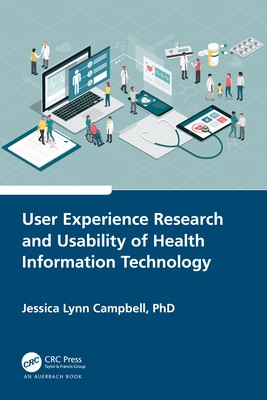
- We will send in 10–14 business days.
- Author: Jessica Campbell
- Publisher: Auerbach Publications
- ISBN-10: 1032162767
- ISBN-13: 9781032162768
- Format: 15.6 x 23.4 x 1.3 cm, minkšti viršeliai
- Language: English
- SAVE -10% with code: EXTRA
User Experience Research and Usability of Health Information Technology (e-book) (used book) | bookbook.eu
Reviews
Description
Health information technology (HIT) is a critical component of the modern healthcare system. Yet, to be effective and safely implemented in healthcare organizations and physicians and patients' lives, it must be usable and useful. User Experience (UX) research is required throughout the full system design lifecycle of HIT products, which involve a user-centered--human-centered approach. User Experience Research and Usability of Health Information Technology discusses UX research frameworks, study designs, methods, data analysis techniques, and a variety of data collection instruments and tools that can be used to conduct UX research in the healthcare space that involve HIT and digital health. This book is for academics and scholars to be used to design studies for graduate dissertation work, independent research, or as a textbook for UX/usability courses in health informatics or related health information and communication courses. This book is also useful for UX practitioners as it provides guidance on how to design a user research or usability study and focuses on leveraging mixed-methods, including step-by-step by instructions and best practices for conducting:
- Field studies
- Interviews
- Focus groups
- Diary studies
- Surveys
- Heuristic evaluation
- Cognitive walkthrough
- Think aloud
Standardized surveys and retrospective questionnaires (SUS, Post-study System Usability Questionnaire (PSSUQ) are also included. UX researchers and healthcare professionals will gain an understanding of how to design a rigorous, yet feasible study that generates useful insights to inform the design of usable HIT. Everything from consent forms to how many participants to include in a usability study is covered in this book. The author encourages user-centered design (UCD), mixed-methods, and collaboration amongst interdisciplinary teams. Knowledge from many inter-related disciplines, like psychology, technical communication (TC), and human-computer interaction (HCI), and experiential knowledge from experts is offered throughout the text.
EXTRA 10 % discount with code: EXTRA
The promotion ends in 21d.09:09:40
The discount code is valid when purchasing from 10 €. Discounts do not stack.
- Author: Jessica Campbell
- Publisher: Auerbach Publications
- ISBN-10: 1032162767
- ISBN-13: 9781032162768
- Format: 15.6 x 23.4 x 1.3 cm, minkšti viršeliai
- Language: English English
Health information technology (HIT) is a critical component of the modern healthcare system. Yet, to be effective and safely implemented in healthcare organizations and physicians and patients' lives, it must be usable and useful. User Experience (UX) research is required throughout the full system design lifecycle of HIT products, which involve a user-centered--human-centered approach. User Experience Research and Usability of Health Information Technology discusses UX research frameworks, study designs, methods, data analysis techniques, and a variety of data collection instruments and tools that can be used to conduct UX research in the healthcare space that involve HIT and digital health. This book is for academics and scholars to be used to design studies for graduate dissertation work, independent research, or as a textbook for UX/usability courses in health informatics or related health information and communication courses. This book is also useful for UX practitioners as it provides guidance on how to design a user research or usability study and focuses on leveraging mixed-methods, including step-by-step by instructions and best practices for conducting:
- Field studies
- Interviews
- Focus groups
- Diary studies
- Surveys
- Heuristic evaluation
- Cognitive walkthrough
- Think aloud
Standardized surveys and retrospective questionnaires (SUS, Post-study System Usability Questionnaire (PSSUQ) are also included. UX researchers and healthcare professionals will gain an understanding of how to design a rigorous, yet feasible study that generates useful insights to inform the design of usable HIT. Everything from consent forms to how many participants to include in a usability study is covered in this book. The author encourages user-centered design (UCD), mixed-methods, and collaboration amongst interdisciplinary teams. Knowledge from many inter-related disciplines, like psychology, technical communication (TC), and human-computer interaction (HCI), and experiential knowledge from experts is offered throughout the text.


Reviews